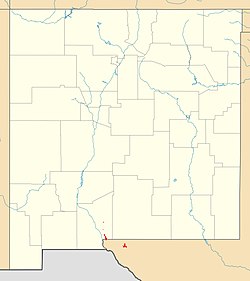| Bishop Cap Formation | |
|---|---|
| Stratigraphic range: Moscovian–Kasimovian PreꞒ Ꞓ O S D C P T J K Pg N | |
| Type | Formation |
| Underlies | Panther Seep Formation |
| Overlies | Berino Formation |
| Thickness | 180 m (590 ft) |
| Lithology | |
| Primary | Shale |
| Other | Limestone |
| Location | |
| Coordinates | 31°58′0″N 106°31′30″W / 31.96667°N 106.52500°W / 31.96667; -106.52500 |
| Region | New Mexico Texas |
| Country | United States |
| Type section | |
| Named for | Bishop Cap (mountain) |
| Named by | L.A. Nelson |
| Year defined | 1937 |
  | |
The Bishop Cap Formation is a geologic formation in the Franklin Mountains of southern New Mexico and western Texas and the Hueco Mountains of western Texas. It preserves fossils dating back to the Moscovian to Kasimovian Ages of the early Pennsylvanian.
Description
The formation consists of brown to gray shale alternating with thin ray ledges of limestone. Shale makes up 65 to 75 percent of the formation. The total thickness is up to 180 meters (590 ft). The formation rests on the Berino Formation and is overlain by the Panther Seep Formation.
Fossils
The formation is highly fossiliferous, with a fauna dominated by snails, brachiopods (Neospirifer, Crurithyris, Mesolobus), and clams, but is less diverse than the underlying Berino Formation. The lower beds contain the fusulinids Wedekindellina euthysepta and Fusulina distenta. Opercula of cephalopods (possibly Liroceras) have been found in the formation, as have shells of Bellerophon, Phestia, and Euphemites.
History of investigation
The unit was designated the Bishop Cap Member of the Magdalena Group by L.A. Nelson in 1937. In 2001, B. Kues recommended abandoning the Magdalena Group and raising its members, including the Bishop Cap, to formation rank.
See also
References
- ^ Harbour, R.L. (1972). "Geology of the northern Franklin Mountains, Texas and New Mexico". U.S. Geological Survey Bulletin. 1298. doi:10.3133/b1298.
- Kues, B.S.; Giles, K.A. (2004). "The late Paleozoic Ancestral Rocky Mountain system in New Mexico". In Mack, G.H.; Giles, K.A. (eds.). The geology of New Mexico. A geologic history (Special Volume 11). New Mexico Geological Society. pp. 95–136.
- ^ Kues, B.S. (2001). "The Pennsylvanian System in New Mexico; Overview with suggestions for revisions of stratigraphic nomenclature" (PDF). New Mexico Geology. 23 (4): 103–122. Retrieved 18 September 2020.
- Nelson, L.A. (1940). "Paleozoic stratigraphy of the Franklin Mountains, West Texas". American Association of Petroleum Geologists Bulletin. 24 (1): 157–172. doi:10.1306/3D93319A-16B1-11D7-8645000102C1865D.
- ^ Thompson, E.; Yochelson, E.; Flower, R. (1980). "Aptychi from the Pennsylvanian of West Texas". Journal of Paleontology. 54 (5): 903–909. JSTOR 1304355.
- Nelson, L.A. (1937). "Gastropoda from the Pennsylvanian (Magdalena) of the Franklin Mountains of west Texas ". Colorado University Studies. 25 (1): 89–91.